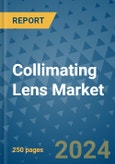The global collimating lens market is poised for significant growth, with a projected increase from US$ 380 million in 2024 to US$ 560 million by 2031, reflecting a robust 6.0% compound annual growth rate (CAGR). A comprehensive analysis of the market dynamics and key growth factors provides insights into the future trajectory of this essential industry.
This product will be delivered within 1-3 business days.
Factors Driving Growth in the Collimating Lens Industry:
- Escalating demand for high-end microscopy systems is driving sales of collimating lenses, as they are essential components in these systems.
- The increasing importance of fiber optics collimating lenses is expanding the market, driven by their rising usage in various applications.
- High adoption of LEDs is boosting demand for collimating lenses, as these lenses enhance the efficiency and effectiveness of LED lighting systems.
- Growing popularity of collimating lenses for display measurement is fostering market development, particularly for applications like flicker measurement and color analysis.
- Integration of collimating lenses in modern vehicles is bolstering sales, as they are utilized in vehicle illumination systems.
- Increasing usage of spectrometers is creating growth prospects for the market, as collimating lenses are essential components in spectrometer setups.
- Growing awareness about the benefits of aspheric lenses over conventional lenses is supporting market expansion, driving demand for collimating lenses.
- Introduction of economical custom-design collimating lenses is triggering sales, making these lenses more accessible to a wider range of customers.
Factors Propelling Demand for Collimating Lenses:
- Increasing usage of LEDs across various applications is driving demand for collimating lenses, which optimize LED light output.
- Expansion of the healthcare market is boosting demand for medical devices incorporating collimating lenses, such as lasers and endoscopes.
- Augmented reality and virtual reality technologies are driving demand for collimating lenses as essential components in these systems.
- Aerospace and defense applications, including targeting systems and surveillance cameras, are driving significant demand for collimating lenses.
- The growing need for high-quality optics in applications like microscopy and spectroscopy is creating lucrative opportunities for collimating lens manufacturers.
Factors Limiting Expansion of the Collimating Lens Industry:
- High cost of collimating lenses is a significant barrier, particularly for specialized designs, limiting their adoption in certain markets.
- Alternative technologies such as diffractive optics and holographic optics provide substitutes in some applications, reducing the demand for collimating lenses.
- Collimating lenses serve unique purposes and are not as widely used as other optical components, limiting their overall market potential.
- Complex designs and high accuracy requirements make collimating lens production challenging, resulting in longer lead times, higher manufacturing costs, and limited production numbers, thereby constraining market expansion.
Country-wise Insights
China:
The collimating lens market in China is anticipated to maintain its global dominance, driven by its significant presence in the thriving automotive sector. The market has shown consistent growth from 2019 to 2023 and is expected to continue expanding steadily over the next decade. Factors such as advances in spectroscopy, high adoption of LiDAR technology, and the presence of key manufacturers will contribute to the market's growth trajectory.Japan:
Japan's collimating lens market has experienced steady growth in recent years and is expected to continue this trend. The increasing integration of collimating lenses in medical devices like endoscopes and medical imaging equipment is a key driver for market expansion. Additionally, the widespread use of LED lighting in various applications is fueling demand for collimating lenses in Japan.Category-wise Analysis
The LED segment is projected to lead the market, supported by growing applications in healthcare, automobile, and other sectors. Furthermore, the automotive industry will remain the leading end user of collimating lenses, driven by the adoption of advanced lighting technologies to differentiate products.Competitive Analysis
Key collimating lens manufacturers are actively expanding their portfolios and forming strategic partnerships to enhance their market presence and revenue share. These efforts underscore the competitive dynamics within the industry and the commitment to innovation and growth.Key Companies Profiled
- Lightpath Technologies Inc.
- Ocean Optics
- Ingeneric GmbH
- Trioptics GmbH
- Avantes Bv
- Auer Lighting GmbH
- IPG Photonics Corporation
- Optikos Corporation
- The Optoelectronics Co. Ltd.
- Thorlabs Inc.
- Axetris AG
Collimating Lens Market Segmentation:
By Light Source:
- LED
- Laser
By End Use:
- Healthcare
- LiDAR
- Automobile
- Light and Display Measurement
- Spectroscopy
- Interferometry
By Material:
- Glass
- Plastic
By Wavelength:
- Less than 1000 nm
- 1000nm to 1500 nm
- 1500nm to 2000 nm
- Greater than 2000 nm
By Region:
- North America
- Latin America
- Europe
- Asia Pacific
- Middle East and Africa
This product will be delivered within 1-3 business days.
Table of Contents
1. Executive Summary
2. Market Overview
3. Global Collimating Lens Market Outlook, 2018 - 2031
4. North America Collimating Lens Market Outlook, 2018 - 2031
5. Europe Collimating Lens Market Outlook, 2018 - 2031
6. Asia Pacific Collimating Lens Market Outlook, 2018 - 2031
7. Latin America Collimating Lens Market Outlook, 2018 - 2031
8. Middle East & Africa Collimating Lens Market Outlook, 2018 - 2031
9. Competitive Landscape
10. Appendix
Companies Mentioned
- Lightpath Technologies, Inc.
- Ocean Optics, Inc.
- Ingeneric GmbH
- Trioptics GmbH
- Avantes Bv
- Auer Lighting GmbH
- IPG Photonics Corporation
- Optikos Corporation
- The Optoelectronics Co. Ltd.
- Thorlabs Inc.
- AMS Technologies AG
- Axetris AG
- Broadcom Limited
- Bentham Instruments Limited
- Casix, Inc.
- Edmund Optics Inc.
- Fisba AG
- Hamamatsu Photonics K.K
- Opto-Line, Inc.
- Ushio America, Inc.
Methodology

LOADING...








